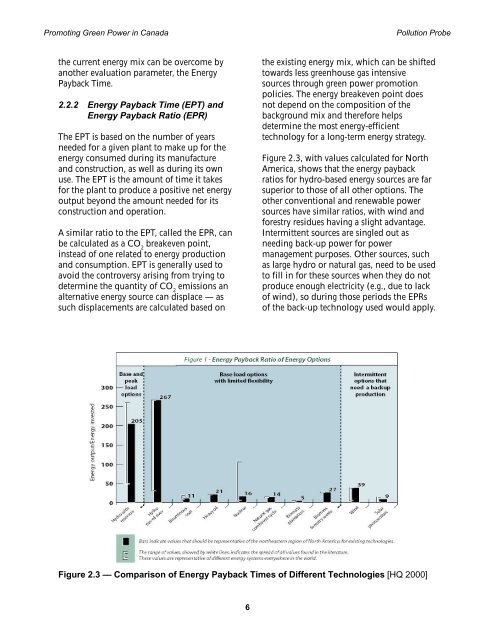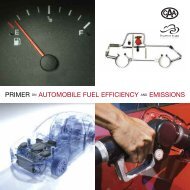Promoting Green Power in Canada - Centre for Human Settlements
Promoting Green Power in Canada - Centre for Human Settlements
Promoting Green Power in Canada - Centre for Human Settlements
- No tags were found...
You also want an ePaper? Increase the reach of your titles
YUMPU automatically turns print PDFs into web optimized ePapers that Google loves.
<strong>Promot<strong>in</strong>g</strong> <strong>Green</strong> <strong>Power</strong> <strong>in</strong> <strong>Canada</strong> Pollution Probethe current energy mix can be overcome byanother evaluation parameter, the EnergyPayback Time.2.2.2 Energy Payback Time (EPT) andEnergy Payback Ratio (EPR)The EPT is based on the number of yearsneeded <strong>for</strong> a given plant to make up <strong>for</strong> theenergy consumed dur<strong>in</strong>g its manufactureand construction, as well as dur<strong>in</strong>g its ownuse. The EPT is the amount of time it takes<strong>for</strong> the plant to produce a positive net energyoutput beyond the amount needed <strong>for</strong> itsconstruction and operation.A similar ratio to the EPT, called the EPR, canbe calculated as a CO 2breakeven po<strong>in</strong>t,<strong>in</strong>stead of one related to energy productionand consumption. EPT is generally used toavoid the controversy aris<strong>in</strong>g from try<strong>in</strong>g todeterm<strong>in</strong>e the quantity of CO 2emissions analternative energy source can displace — assuch displacements are calculated based onthe exist<strong>in</strong>g energy mix, which can be shiftedtowards less greenhouse gas <strong>in</strong>tensivesources through green power promotionpolicies. The energy breakeven po<strong>in</strong>t doesnot depend on the composition of thebackground mix and there<strong>for</strong>e helpsdeterm<strong>in</strong>e the most energy-efficienttechnology <strong>for</strong> a long-term energy strategy.Figure 2.3, with values calculated <strong>for</strong> NorthAmerica, shows that the energy paybackratios <strong>for</strong> hydro-based energy sources are farsuperior to those of all other options. Theother conventional and renewable powersources have similar ratios, with w<strong>in</strong>d and<strong>for</strong>estry residues hav<strong>in</strong>g a slight advantage.Intermittent sources are s<strong>in</strong>gled out asneed<strong>in</strong>g back-up power <strong>for</strong> powermanagement purposes. Other sources, suchas large hydro or natural gas, need to be usedto fill <strong>in</strong> <strong>for</strong> these sources when they do notproduce enough electricity (e.g., due to lackof w<strong>in</strong>d), so dur<strong>in</strong>g those periods the EPRsof the back-up technology used would apply.Figure 2.3 — Comparison of Energy Payback Times of Different Technologies [HQ 2000]6
















